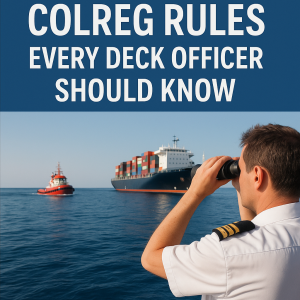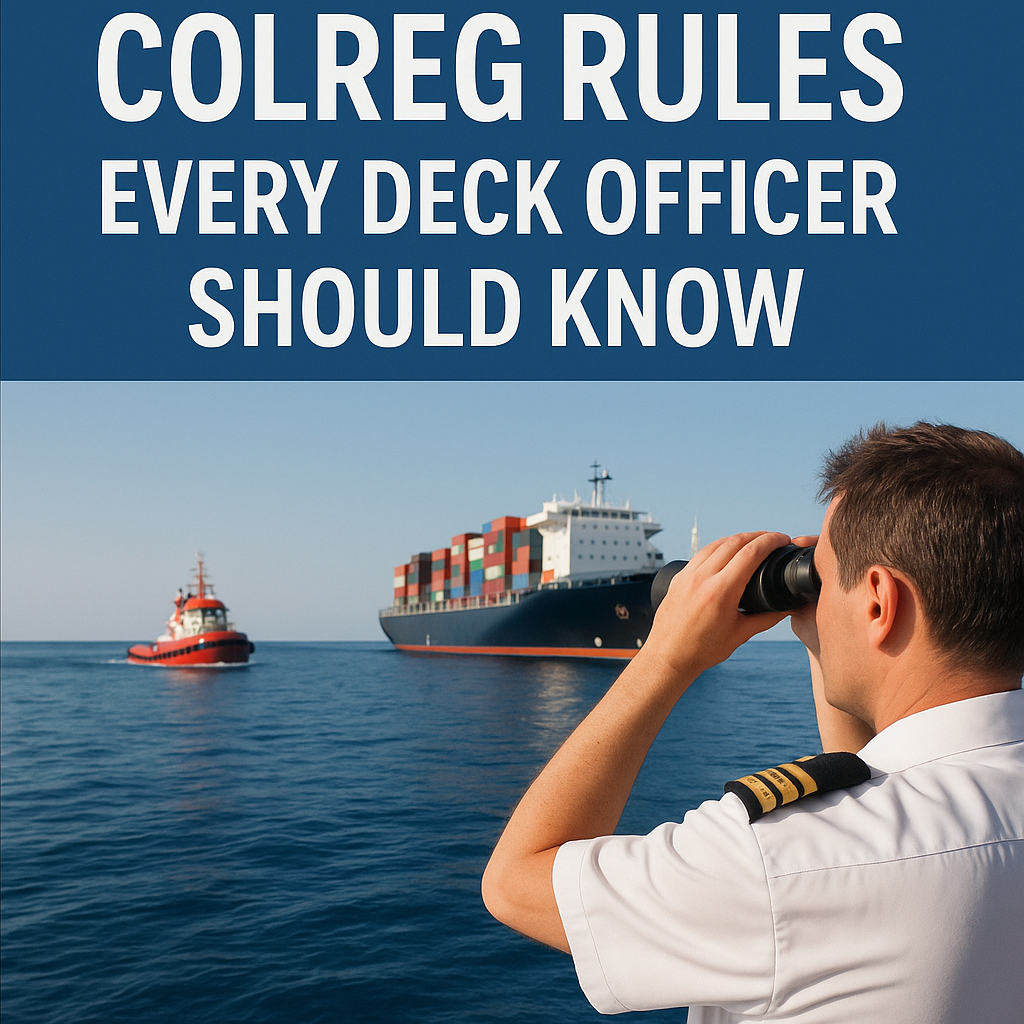Explore the top 10 COLREG rules from the 1972 Convention every deck officer must master. Learn how proper look-out, safe speed, overtaking, and restricted visibility rules prevent collisions and save lives at sea.

Every Watch Starts with COLREG Proficiency
Imagine standing watch on the bridge—fog obscures everything, radar echoes appear, and traffic converges. It’s in these critical moments that COLREG (Collision Regulations) compliance becomes a mariner’s lifeline. Since its entry into force in 1977, the 1972 COLREG has shaped how vessels safely interact at sea.
Deck officers who master its top rules—such as look-out, safe speed, overtaking, crossing, and restricted visibility—don’t just work by the book; they steer clear of collisions and uphold maritime safety worldwide.
1) Rule 5 – Proper Look-Out
COLREG Rule 5 mandates every vessel maintain a thorough lookout by sight, hearing, and available means like radar . A well-trained look-out often spots hazards before radar does.
Story from the deck: In congested Singapore Strait traffic, one vigilant Third Officer spotted a rapidly approaching tug on radar. Acting early, the vessel adjusted course safely—preventing what could’ve become a serious accident.
2) Rule 6 – Safe Speed
Rule 6 requires vessels to maintain a safe speed considering visibility, traffic, weather, size, and stopping distance .
In practice, this means slowing down in heavy fog or at night—even if radar suggests the path is clear—because assumptions based on limited data can be perilous.
3) Rule 7 – Risk of Collision
Rule 7 warns: never assume no collision risk with scanty data. Always assess using all available information .
For example, a bearing that remains constant as a vessel approaches means collision is imminent. Ignoring this may lead to tragedy.
4) Rule 8 – Action to Avoid Collision
Rule 8 insists actions should be early and decisive—large enough to be recognized, and consistent with good seamanship .
A tug once altered course slightly when crossing in front of a moving bulker; the delay led to near-miss with minimal avoidance. Rule 8 teaches: when in doubt, act boldly.
5) Rule 10 – Traffic Separation Schemes (TSS)
Traffic Lanes in TSS areas are enforceable. Rule 10 mandates using them correctly—stay in your lane, cross at right angles, and keep clear of smaller vessels .
In Dover Strait’s TSS, collisions dropped from 60 to 16 over two decades—a testament to the rule’s life‑saving impact .
6) Rule 13 – Overtaking
An overtaking vessel must keep clear of the vessel being overtaken. Even at a distance, if your bearing remains within 22.5° abaft the beam, you’re overtaking and must stay clear.
7) Rule 14 – Head-On Situation
Power-driven vessels must both turn starboard in head-on convergence to pass port-to-port.
This standardized response avoids confusion and is fundamental knowledge for collision prevention.
8) Rule 15 – Crossing Situation
If another vessel is on your starboard (right), you are the give-way vessel and must maneuver early to keep clear .
Rule 15 avoids finger-pointing—it clarifies responsibilities based on the positions of vessels relative to each other.
9) Rule 17 – Stand-On Vessel Conduct
The stand-on vessel must maintain course and speed, but if the give-way vessel doesn’t act, it must take avoiding action at the last minute .
This rule also clarifies that “stand-on” is not entitlement—it’s responsibility with oversight.
10) Rule 19 – Restricted Visibility
In fog, mist, or any condition of limited sight, Rule 19 applies—reduce speed, sound fog signals, post extra lookouts, and be ready to stop .
Many accidents happen at night or in fog when vessels over-rely on technology and lose situational awareness. Officers who slow and listen save lives.
Case Studies
-
Evergreen Suez Canal Crisis (2021): Confusion in crossing and narrow channel maneuvers may have breached Rules 8, 15, and 17—revealing that even well-equipped vessels can falter without rigid rule adherence .
-
Fog Collision Off Antarctic Coast: A bulk carrier and fishing trawler collided when neither slowed down or posted extra lookouts—Rule 19 violations clear in hindsight.
FAQ
Q1: Is “right of way” accurate in COLREG?
Not really. There is no absolute right—vessels are either “give-way” or “stand-on,” each bearing duties rather than ownership of a path .
Q2: Can you deviate from COLREGs?
Yes—Rule 2 allows departure if necessary to avoid immediate danger, but you must still exercise reasonable seamanship.
Q3: How often should look-outs be rotated?
Always during heavy traffic or restricted visibility—but human fatigue means schedules must allow rest and high alertness.
Q4: What’s the difference between Rules 8 and 17?
Rule 8 is for give-way vessels—to act. Rule 17 is for stand-on vessels—to maintain, but intervene if needed.
Q5: Do COLREGs apply in traffic separation zones?
Absolutely. TSS don’t override other rules; they add obligations under Rule 10.
Conclusion: COLREG Mastery Means Safer Seas
These top 10 COLREG rules form the backbone of collision prevention. Understanding them is more than regulation—it’s good seamanship. In today’s world of advanced radar and AIS, nothing replaces early detection, decisive action, and disciplined watchkeeping. For every officer on watch, these rules aren’t just guidelines—they are the language of safety and competence.
References
-
IMO. (n.d.). Convention on the International Regulations for Preventing Collisions at Sea, 1972
-
IMO. (n.d.). COLREG Preventing Collisions at Sea imo.org
-
Coastal Safety. (n.d.). COLREG Overview coastalsafety.com
-
Wikipedia. (2025). International Regulations for Preventing Collisions at Sea en.wikipedia.org
-
Norton Rose Fulbright. (2024). COLREGs and Autonomous Shipping
-
IAIN Study. (1981). Collision reduction in Dover Strait


Lives of onboard people is in hands of navigation officers